by Lorri | Nov 7, 2012 | UnCorked
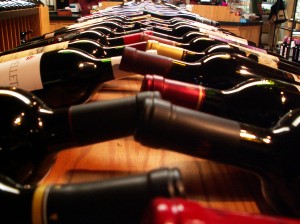 Fall is upon us and along with it come the annual pressures of the holiday planning. Travel reservations are being confirmed, recipes are being clipped and budgets are getting checked. If you’re like us, wine will be on the menu, so it’s an easy place to start, allowing one less stress ahead. If you’ve avoided serving wine in the past because you thought it was too expensive, reconsider. It’s no longer a pricey treat; it can fit into almost any budget.
Fall is upon us and along with it come the annual pressures of the holiday planning. Travel reservations are being confirmed, recipes are being clipped and budgets are getting checked. If you’re like us, wine will be on the menu, so it’s an easy place to start, allowing one less stress ahead. If you’ve avoided serving wine in the past because you thought it was too expensive, reconsider. It’s no longer a pricey treat; it can fit into almost any budget.
A day can make a difference. Look for the best opportunity for savings at fine wine retailers, whether it’s buying by the case or on “wine day.” If you were told you could save 10 percent to 20 percent for simply buying your wine on a certain day of the week, most likely that would be an easy choice.
Make friends with your wine shop staff. With any shopping relationship you should get to know your retailer. With simple conversations they will begin to understand your likes and dislikes and can guide you to the best wines available. And always remember, the best way to find great savings is to simply ask.
Respect the box. With more and more quality wines available, boxed wine is ideal for large or small gatherings. A 3-liter box is the same volume as four standard wine bottles, yet many boxed wines sell for less than $20. With the airtight preservation you can keep it up to a month, making it a solution for parties when you aren’t sure the amount that will be consumed. If you want to remove the stigma ofthe image, simply pour into decorative wine carafes before serving.
Explore the wine world. Many European regions offer tasty wine values, but searching for a specific bottle can beexhausting with the myriad labels, producers and vintage variations. Consider emerging wine regions with little or no recognition. Chile and Argentina continue to offer remarkable value, but also consider Spanish tempranillo and Italian chianti.
Keep your options open. Many quality wines are available at value prices. For quick savings, substitute blanc de blanc in place of vintage Champagne, malbec for cabernet sauvignon, merlot for pinot noir and late-bottled vintage port for vintage port.
THE VALUES UNDER $15
- 2011 Chateau Ste. Michelle Riesling, Washington (about $11 retail)
- NV La Marca Prosecco, Italy (about $14 retail)
- 2011 PromisQous White Blend, California (about $9 retail)
- 2011 Apothic White Winemakers Blend, California (about $13 retail)
- 2011 Bogle Vineyards Merlot, California (about $10 retail)
- 2011 Root One Carmenere, Chile (about $11 retail)
- 2011 Grayson Cellars Lot 10 Cabernet Sauvignon, California (about $12 retail)
by Lorri | Oct 31, 2012 | UnCorked
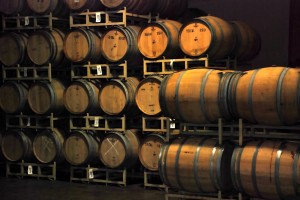 Last week a group of students and I addressed the topic of “The Impact of Wood Usage in Wine Storage and Maturation.”
Last week a group of students and I addressed the topic of “The Impact of Wood Usage in Wine Storage and Maturation.”
You, as they, would probably also have been yawning as the first PowerPoint slide was projected onto the screen. (Did I mention it was late afternoon on a Friday?) But the class delved into the discussion.
We like to think of wood aged wine as spending its days and nights nestled in dark cellars slowly evolving inside expensive oak barrels, eventually revealing its complex and nuanced character. That scenario is most likely not the case if the wine you are buying costs $12 or less. This is not to say that you will not find wood aromas and tastes in lower-priced wines; it only means you are experiencing a “wood usage option.”
The use of alternative techniques originated in Australia, a leader in revolutionary winemaking techniques. Australians tend to take a pragmatic approach to their craft – for instance, the use of mechanical harvesters in the place of hand harvesting to efficiently grow and harvest more grapes. The simple solution: Put a tractor in the field rather than a picking crew.
Want to soften, add texture and stabilize the tannin in wines? Take a shortcut; throw a few oak chips into the vat. As with Australia’s many other down-to-earth solutions, this method not only costs less on the winery’s end; the savings trickle down to the consumer by offering the flavor and characteristics of wood at a fraction of the price.
These techniques for imparting wood influence without the expensive barrels include the use of oak staves lowered into the vat or large bags filled with oak chips dipped into the vat, much like a tea bag. A final alternative, which few winemakers use (and is illegal in most countries), is pouring a liquid essence with oak flavor into the vat.
Is this modernized technique a benefit to the wine consumer or another process making the romance of winemaking a thing of the past? There is no easy answer. I love rich, buttery $50 chardonnays that have fermented in expensive oak barrels, but certainly enjoy the simple, clean $10 bottles using alternative methods for my wines.
Perhaps this is a question where the exploration is more fun than finding the answer.
THE VALUES
- 2011 Penfolds Rawson Retreat Chardonnay, Australia (about $12 retail)
- 2011 Yalumba Y SeriesChardonnay, Australia (about $12 retail)
THE SPLURGES
- 2009 Rombauer Carneros Chardonnay, California (about $49 retail)
- 2009 Cambria Katherine’s Vineyard Chardonnay, California (about $32 retail)
by Lorri | Oct 24, 2012 | UnCorked
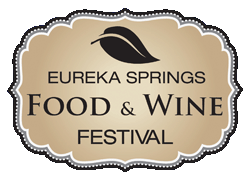 There’s no need to travel to Napa or Sonoma Valley in California for wine and food bliss because it can be found right here in our home state. Eureka Springs has long been a favorite destination for unique dining and shopping year-round. And the Eureka Springs Food and Wine Festival is one event wine lovers won’t want to miss. The colossal event featuring wine, food, art and community exploration runs Nov. 7-11.
There’s no need to travel to Napa or Sonoma Valley in California for wine and food bliss because it can be found right here in our home state. Eureka Springs has long been a favorite destination for unique dining and shopping year-round. And the Eureka Springs Food and Wine Festival is one event wine lovers won’t want to miss. The colossal event featuring wine, food, art and community exploration runs Nov. 7-11.
The event begins with Arkansas’ newest winemaking success, Margie Roeland’s Raimondo Winery “First Sip” release party Nov. 7. Raimondo Winery is a family-owned winery located on Norfork Lake that specializes in handcrafted Italian and Iberian wines. The winery’s output will also be featured at a dinner hosted by DeVito’s restaurant Nov. 11.
Growing up in Harrison with the original DeVito’s at Bear Creek Springs, I can confirm that this is an Italian dining experience not to be missed. Each course will be paired with a wine, and Raimondo’s extra-virgin olive oilsand infused balsamic vinegars will be used in the chef’s creations.
Many restaurants will be dedicating nightly food and wine pairing specialties throughout the week exclusive to the festival. Linda Hager, owner and chef at the Cottage Inn, will host a California Wine Dinner on Nov. 8-11 with each evening showcasing a different four-course meal paired with California wines.
But the festival isn’t just about wine in restaurants. Patrice Gros, co-founder of the Eureka Springs Farmers Market, will be giving a special tour of his U.S. Department of Agriculture-certified organic farm. The Foundation Farm grows more than 30 different vegetables and herbs year-round. Keels Creek Winery will be hosting a barrel/tank Tasting and Amateur Wine Competition on Nov. 10, and culinary instructor Karen Gros will conduct cooking classes focused on French cuisine and locally grown ingredients.
For a complete schedule of events, visit eurekaspringsfoodandwine.com or facebook.com/eurekaspringsfoodwinefestival.
by Lorri | Oct 17, 2012 | UnCorked
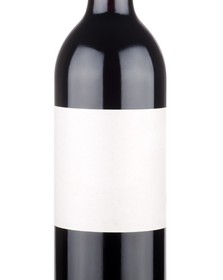 Wine labels can be trendy, appealing and, of course, confusing. Especially if French, Italian or Spanish is not your primary language. Wine labels offer helpful information, but sometimes the unfamiliar terms add to the confusion. To help decipher the code, here are explanations of some common foreign-language label terminology.
Wine labels can be trendy, appealing and, of course, confusing. Especially if French, Italian or Spanish is not your primary language. Wine labels offer helpful information, but sometimes the unfamiliar terms add to the confusion. To help decipher the code, here are explanations of some common foreign-language label terminology.
FRENCH
- Blanc de Blancs: Literally, white of whites. This means white wine made from white grapes. If it appears on a bottle of Champagne it means 100 percent chardonnay grapes were used.
- Blanc de Noirs: Literally, white of blacks. This means white wine made from red grapes. On a Champagne label it means the wine is made from pinot noir and pinot meunier grapes.
- Cote: A slope or hillside. Often it is followed by the name of the slope or hillside, for example, Cotes du Rhone (Hills of Rhone).
- Clos: A term used for a walled vineyard.
- Fut de Chene: The wine was matured in oak barrels.
- Vendange Tardive: Latepicked or late-harvested grapes. This appears on many sweet wine labels.
- Vieilles Vignes: The wine was made from grapes off old vines. On French wine labels it generally signifies a superior wine with concentrated flavors. Keep in mind, though, there is no regulated age for vines to be considered “old.”
ITALIAN
- Abboccato: This refers toa medium-sweet or semi-dry wine.
- Amabile: Meaning pleasant, this refers to a sweet wine.
- Recioto: A Venetian term for a strong sweet wine made from dried grapes.
- Castello: Literally castle, used like the French term chateau to identify an estate or other vineyard location.
SPANISH
- Crianza: Wine that has been aged for two years before release, one year of which has to be in a barrel. Or subjected to another specific aging process defined by the region’s governing body.
- Gran Reserva: A distinction for aged wines. For red wine it means that it has been aged for five years, of which a minimum of two has been spent in a barrel. White and rose wines for four years, with six months spent in wood.
- Abocado: A medium sweet wine.
by Lorri | Oct 10, 2012 | Tips, UnCorked
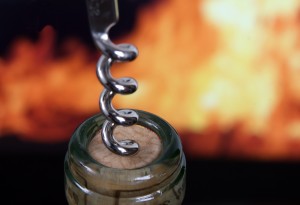 Up to this moment, even the wine list ordering anxiety was only amateur night compared to the angst of sending back your first bottle of wine. Your spouse is whispering to not draw attention, your guest may not know the difference in a chardonnay and pinot grigio and worse, there’s the impending stare from your waiter, the waiter who clearly thinks you’re trying to impress your dining partners.
Up to this moment, even the wine list ordering anxiety was only amateur night compared to the angst of sending back your first bottle of wine. Your spouse is whispering to not draw attention, your guest may not know the difference in a chardonnay and pinot grigio and worse, there’s the impending stare from your waiter, the waiter who clearly thinks you’re trying to impress your dining partners.
My mentor, wine writer Frank Prial said it brilliantly, “At best you will meet your trial with steadfastness and course … at worst you can console yourself that you’ve come a long way from the days when you were afraid to order the bottle in the first place.”
It’s not easy rallying the nerve to send a bottle of wine back or even questioning its condition but there are a few pointers and etiquette guidelines that can help ease the stress.
The ritual remains the same: The waiter opens the bottle, the person who ordered the wine will be asked if he would like to taste. Answer yes, and the waiter will pour a small amount. The diner will give it a quick sniff and take a sip, nodding yes if the wine is not tainted. Obviously, if the wine smells like a musty basement, dirty socks or vinegar you will tell your waiter, who will usually confirm the fault, retrieve a new bottle and begin again.
If you are dining in a restaurant with a knowledgeable staff this task will not be a debate or embarrassing conflict. Your waiter is opening the bottle for the first time at your table so consider from the beginning he is your ally. If you think the bottle has a fault, ask the waiter to taste the wine and offer his opinion. Knowledgeable staff will be able to evaluate and discuss the fault or aroma you are detecting.
Of course it doesn’t make sense to go through an entire dining experience with a bad bottle but there is a difference in a flaw and simply not enjoying the taste. Many times when ordering an unfamiliar varietal, vintage or region, the wine will express itself differently from traditional wines we drink on a regular basis.
This is important because many wines will have an unusual or unfamiliar aroma or taste very specific to the grape. For example, a beautiful old Burgundy pinot noir may have the aromas of barnyard, manure and a touch of mushrooms. It is important to understand this is not a fault but a unique character to the aging wine. Consider asking for a “tasting” pour, if the wine is available by the glass as well as bottle. This helps in the taste and fault confusion before ordering the bottle.
A last tip: the stemware could be the culprit. With industrial restaurant detergents and dishwashers, residue left on the glass can offset the aromas. Sometimes it may be as simple as asking to re-taste in a fresh wine glass.
by Lorri | Oct 3, 2012 | Tips, UnCorked
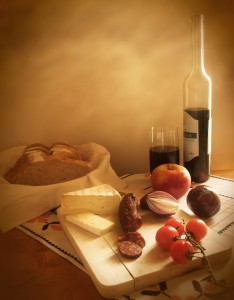 There really are a few ground rules in wine and food pairing, well not really “rules” but more like advice to keep in mind.
There really are a few ground rules in wine and food pairing, well not really “rules” but more like advice to keep in mind.
Follow the logic of the recipe. If a dish contains a certain red or white wine or even beer it generally makes sense to pair the same or a similar bottle with it. If your recipe is a sweet chocolate dessert with raspberries and cherries move in the same progression with a sweet red wine. If the pasta sauce calls for a few dashes of dry red or white wine the same will most likely match the dish.
Put out of your mind most of the rules you’ve heard. “Red wine with red meat” and “white wine with fish” worked for past dining rules but with today’s food fusions it does not always hold true. The only advice most experts agree on is to remember to drink dry wines before sweet wines, light-bodied wines before full-bodied and your wine must always be sweeter than your dessert.
Some foods and wines naturally flatter each other. These are classics for a reason – the match rarely fails. Apple or pear tarts and dessert wines, truffles or mushrooms and pinot noir, lobster and white Burgundy, roasted meats and most red wines, oysters and Champagne, Stilton cheese and port, goat cheese and sauvignon blanc and chilled dry fino sherry with roasted nuts.
Respect tradition – but not unquestioningly. Many countries, Italy and France to name a couple, have been pairingwines with certain dishes for centuries. There may be other pairings but why struggle to find new ones when they have already been perfected.
Chicken is much more than just chicken. Very rarely do we eat simple plain chicken dishes without a sauce or roasting, grilling or basting method. The starting point for chicken pairings can be found in the sauce or marinade. There’s quite a contrast between a delicate cream mushroom sauce and Thai green curry chicken, so consider the overall dish and not simply the chicken. (Same applies to most meat pairings.)
Don’t forget the sides. Generally most vegetables accompanying the meal won’t be powerful enough to dominate the main dish. But if your sides feature strong flavors such as onions, spicy salsas, cabbage or peppers you may need a more full-bodied wine to compete with the flavors.
 Fall is upon us and along with it come the annual pressures of the holiday planning. Travel reservations are being confirmed, recipes are being clipped and budgets are getting checked. If you’re like us, wine will be on the menu, so it’s an easy place to start, allowing one less stress ahead. If you’ve avoided serving wine in the past because you thought it was too expensive, reconsider. It’s no longer a pricey treat; it can fit into almost any budget.
Fall is upon us and along with it come the annual pressures of the holiday planning. Travel reservations are being confirmed, recipes are being clipped and budgets are getting checked. If you’re like us, wine will be on the menu, so it’s an easy place to start, allowing one less stress ahead. If you’ve avoided serving wine in the past because you thought it was too expensive, reconsider. It’s no longer a pricey treat; it can fit into almost any budget. Last week a group of students and I addressed the topic of “The Impact of Wood Usage in Wine Storage and Maturation.”
Last week a group of students and I addressed the topic of “The Impact of Wood Usage in Wine Storage and Maturation.” There’s no need to travel to Napa or Sonoma Valley in California for wine and food bliss because it can be found right here in our home state. Eureka Springs has long been a favorite destination for unique dining and shopping year-round. And the Eureka Springs Food and Wine Festival is one event wine lovers won’t want to miss. The colossal event featuring wine, food, art and community exploration runs Nov. 7-11.
There’s no need to travel to Napa or Sonoma Valley in California for wine and food bliss because it can be found right here in our home state. Eureka Springs has long been a favorite destination for unique dining and shopping year-round. And the Eureka Springs Food and Wine Festival is one event wine lovers won’t want to miss. The colossal event featuring wine, food, art and community exploration runs Nov. 7-11. Wine labels can be trendy, appealing and, of course, confusing. Especially if French, Italian or Spanish is not your primary language. Wine labels offer helpful information, but sometimes the unfamiliar terms add to the confusion. To help decipher the code, here are explanations of some common foreign-language label terminology.
Wine labels can be trendy, appealing and, of course, confusing. Especially if French, Italian or Spanish is not your primary language. Wine labels offer helpful information, but sometimes the unfamiliar terms add to the confusion. To help decipher the code, here are explanations of some common foreign-language label terminology. Up to this moment, even the wine list ordering anxiety was only amateur night compared to the angst of sending back your first bottle of wine. Your spouse is whispering to not draw attention, your guest may not know the difference in a chardonnay and pinot grigio and worse, there’s the impending stare from your waiter, the waiter who clearly thinks you’re trying to impress your dining partners.
Up to this moment, even the wine list ordering anxiety was only amateur night compared to the angst of sending back your first bottle of wine. Your spouse is whispering to not draw attention, your guest may not know the difference in a chardonnay and pinot grigio and worse, there’s the impending stare from your waiter, the waiter who clearly thinks you’re trying to impress your dining partners. There really are a few ground rules in wine and food pairing, well not really “rules” but more like advice to keep in mind.
There really are a few ground rules in wine and food pairing, well not really “rules” but more like advice to keep in mind.